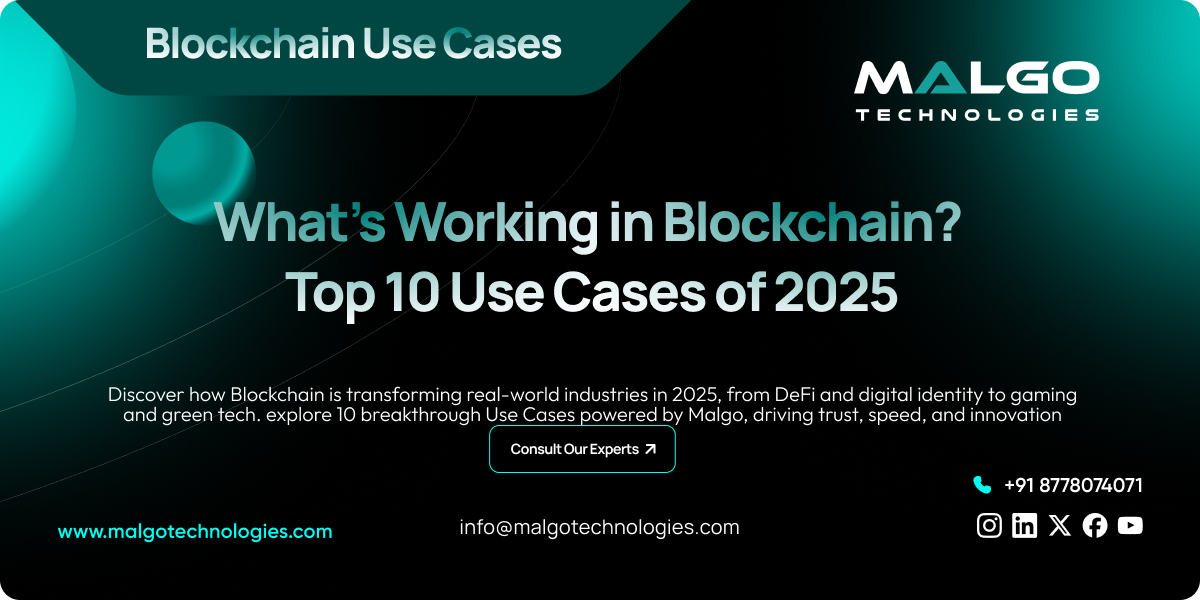Introduction
Blockchain in 2025 is no longer a niche topic for tech circles—it’s a practical technology shaping industries across the globe. Built on peer-to-peer verification and immutable records, blockchain allows people and organizations to share, transact, and record with unmatched transparency and trust.
Overview of Blockchain Technology in 2025
By 2025, blockchain technology has matured. It’s faster, more secure, and scalable enough for real-world applications. With Layer 2 networks and scalable consensus models like Proof-of-Stake or Zero-Knowledge systems, blockchain development is powering tools people now rely on daily. It's not just for cryptocurrencies—it's running behind everyday digital tasks from data access to logistics verification.
Which Industries Will Benefit the Most?
Healthcare, finance, logistics, energy, government services, and gaming are among the industries adopting blockchain most actively. They're turning to this tech to reduce fraud, cut middle layers, improve user control, and boost reliability across digital interactions. Even smaller businesses and individual professionals are starting to plug in through platforms and tools that require little technical setup.
Why Are These Use Cases Gaining Traction?
The shift is being driven by a mix of legal clarity, better infrastructure, and public demand for more control over data and transactions. People are tired of opaque systems. Blockchain offers verifiable proof, real-time access, and lower reliance on third parties, which fits the needs of fast-moving digital ecosystems.
How Can Businesses and Individuals Prepare?
It's wise for businesses to start understanding the practical applications of blockchain—like integrating with wallet-based login systems or using smart contracts for agreements. Individuals should learn how to manage their digital wallets and participate in secure platforms that use verified blockchain protocols. The earlier users get involved, the easier they’ll adapt as adoption spreads.
Top 10 Real-World Blockchain Use Cases to Know in 2025
1. Decentralized Finance (DeFi)
DeFi continues to offer direct financial tools—borrowing, lending, and yield generation—without requiring banks or brokers. Smart contracts lock in terms automatically, so funds can be borrowed or lent transparently. Blockchain in financial services and banking is the foundation enabling this shift. Platforms like Aave, Compound, and MakerDAO are seeing millions of active users moving assets daily.
In 2025, many are using DeFi not just for profit, but to control their money without high fees or long wait times. This independence is especially useful in countries with unstable banking systems or currency controls.
2. Supply Chain Tracking and Audit Trails
Blockchain provides timestamped logs that trace a product's full lifecycle, from origin to delivery. Each step is recorded in a way that can’t be changed, helping companies confirm quality, track sourcing, and fix bottlenecks fast.
Industries like agriculture, electronics, and fashion are using it to cut down on counterfeits and make sure goods meet safety and ethical standards. These records help everyone involved—producers, regulators, and buyers—know exactly what they’re dealing with.
3. Digital Identity and Access Control
Instead of handing over personal details to websites or companies, people can now confirm who they are through secure digital wallets. These decentralized IDs (DIDs) allow login and verification without revealing sensitive data.
This shift gives more privacy and fewer risks tied to data leaks. Systems like Worldcoin and Ethereum Name Service are creating ID tools that people control directly—without needing to rely on centralized servers.
4. Health Record Access and Sharing
Medical records are now easier to share between trusted health providers using blockchain. Instead of scattered systems and repeat tests, people can grant access to their full health history when needed.
Blockchain ensures records are accurate and shared only with permission. That means patients, doctors, labs, and hospitals can work together faster, with fewer errors and better coordination in emergencies or remote care.
5. Property Sales and Title Ownership
In property deals, blockchain helps track land titles and ownership with permanent proof. Once data is added, it can’t be erased or edited without full transparency, which lowers the risk of legal disputes.
Smart contracts are handling the sale process too—automating transfer of funds and titles when agreed terms are met. That saves time, lowers fraud, and reduces the need for expensive third-party verifications.
6. Voting Systems with Proof
Blockchain voting offers real-time tracking of each vote while keeping voters' identities private. Systems being tested in several regions allow secure remote voting with instant tally verification.
These systems reduce ballot fraud and remove the need for physical supervision or recounts. Because all actions are recorded immutably, the results can be trusted by both voters and auditors without delay.
7. Online Copyright Claims and Creator Rights
Artists and content creators are using blockchain to timestamp their work—proving ownership and protecting against misuse. From images to songs to blog posts, creators can register digital assets with exact date and authorship info.
This makes disputes easier to resolve. Buyers and fans can track if they’re supporting the original owner, and royalties can be programmed to send instantly when content is used or sold again.
8. Global Payments without Intermediaries
Stablecoins and blockchain payments now handle fast money transfers between countries with fewer fees. Platforms like USDC, Stellar, and Ripple are used by both companies and individuals to skip expensive cross-border systems.
Transfers happen within seconds or minutes, not days, and users can track each payment through public logs. It's especially useful for freelancers, travelers, and global contractors who want to avoid delays and conversions.
9. Tracking Emissions and Carbon Offsets
Blockchain is helping verify how much carbon companies emit—and how much they offset. Instead of trusting self-reported data, emissions and offsets are tracked in open records.
This gives both regulators and the public a better picture of who’s polluting, who’s improving, and how carbon credits are traded or retired. The trust in data helps drive better sustainability results.
10. Digital Assets and In-Game Items
Gamers now buy and sell in-game items as blockchain assets, meaning ownership can be proven and transferred. Whether it's skins, weapons, or tokens, these assets can carry value beyond just one game.
Developers are adding marketplaces and item integration across platforms, giving players more control over their purchases. Since assets are recorded on-chain, buyers know they’re getting verified originals with resale options.
| Use Case | Application | Function |
| Decentralized Finance (DeFi) | Lending, Borrowing, Yield Protocols | Automate financial services with smart contracts and reduce intermediaries |
| Supply Chain Tracking | Product Verification, Delivery Logs | Provide timestamped, tamper-proof tracking from source to delivery |
| Digital Identity and Access Control | Wallet Sign-ins, Decentralized ID Systems | Enable identity verification without exposing personal data |
| Health Record Access | Medical Data Portability, Privacy Controls | Give patients control over health record sharing and history access |
| Property Sales and Ownership | Digital Land Registry, Smart Sale Contracts | Record property titles and execute sales through programmable agreements |
| Voting Systems | Digital Ballot Submission, Instant Result Verification | Securely record and count votes with public audit capability |
| Online Copyright and Creator Rights | IP Timestamping, Royalty Tracking | Prove content ownership and track usage or resale of digital works |
| Global Payments | Cross-Border Transfers, Stablecoin Transactions | Send money globally with faster settlements and lower fees |
| Emissions and Carbon Tracking | Carbon Credit Trading, Pollution Logs | Publicly verify emissions and track offsets in real time |
| Digital Assets and In-Game Items | NFT Game Items, Marketplace Integration | Secure ownership of digital items with tradeability across platforms |
How Blockchain Impacts Daily and Business Use?
What People Are Actually Doing with Blockchain?
From checking a coffee's origin to signing contracts online, people are using blockchain daily without needing deep technical knowledge. Apps and sites have simplified the experience—letting users enjoy benefits like privacy, transparency, and lower costs without changing habits too much.
Larger businesses are running loyalty programs, managing suppliers, and automating payments through blockchain. Even startups are embedding it to reduce fraud or give users more control.
Who Is Building Solutions?
Thousands of open-source developers and startups are building blockchain-based platforms. Public chains like Ethereum, Solana, and Avalanche continue to lead, while niche chains support specific sectors such as healthcare or gaming.
These developers are focused on real-world usability, often working with communities and businesses to test and improve what’s being built. That feedback loop helps produce practical tools with everyday value.
Why Choose Malgo for Blockchain Solutions?
Real-Use Support with Blockchain Protocols
Malgo works across major blockchain networks, making it easier for developers and businesses to integrate with protocols that are already active. The platform focuses on utility, not hype—so users get real value through tested, scalable tools.
Fast Setup and Reliable Tools
Whether someone is building an app, storing data, or setting up wallet access, Malgo helps connect the pieces quickly. Time-saving templates and secure environments help avoid delays and lower risk when launching.
Trust Signals Built Into the Platform
With on-chain verification, data controls, and active monitoring, Malgo adds extra layers of trust. That means fewer outages, stronger user protections, and easier compliance when needed.
Conclusion
Blockchain in 2025 is working in places people care about: health, money, privacy, and ownership. It’s not just a background technology—it’s something individuals and businesses are using to solve daily problems. With tools like Malgo, the barrier to entry is lower, and the ability to build trustworthy systems is more within reach than ever.
Frequently Asked Questions
In 2025, one of the most common uses of blockchain is in decentralized finance (DeFi), where users can borrow, lend, and trade assets directly using smart contracts—no bank required.
Blockchain records every movement of goods on a secure ledger, giving manufacturers and consumers proof of origin, shipment details, and delivery history in real-time.
Digital identities on blockchain allow people to verify who they are online without sharing personal documents, helping reduce fraud and password-related risks.
Yes, it gives patients control over their records, and makes it easier to securely share health data between clinics, labs, and hospitals while keeping it protected from tampering.
Properties can be tokenized and transferred through blockchain-based smart contracts, which reduces paperwork, speeds up the process, and improves transaction accuracy.


